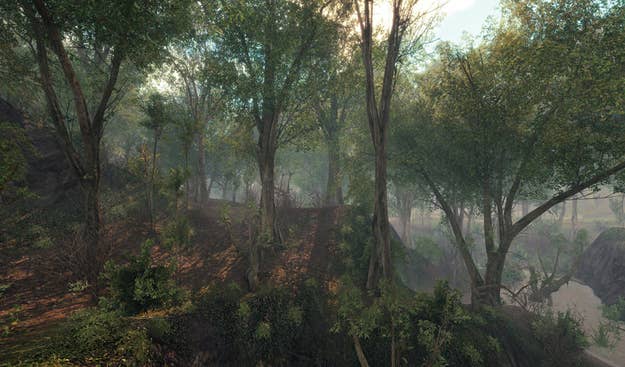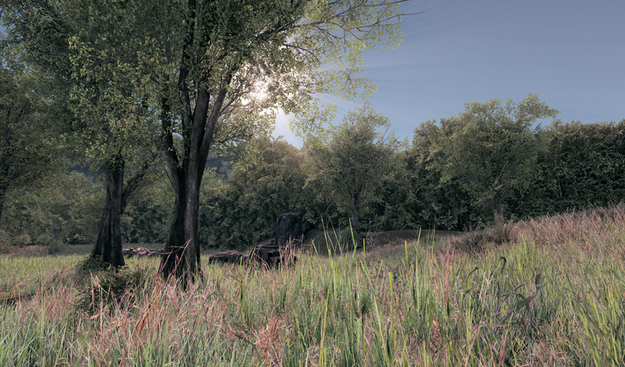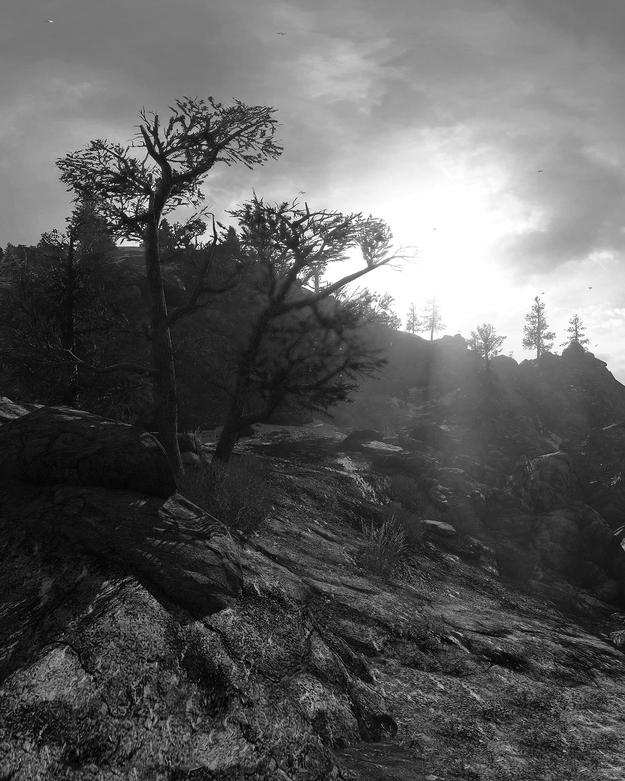
As I write this, 229,984 people are playing Battlefield 3 online, on landscapes ranging from the Caspian border to an island beach in the Persian Gulf. Each one is as close to photorealistic as modern game engine technology allows. Add in virtual landscapes from the likes of Red Dead Redemption, the Crysis series, the Just Cause series, the Medal of Honor games and Skyrim and you get millions of hours of development work, on par with building an aircraft carrier or a stadium.
Most of the time, these landscapes are just pretty places to shoot people. But more recently, artists have used video games to mint a new kind of art.
The picture above is by Mark Tribe, showing off a forest scene from a recent first person shooter. (Tribe declined to say which one; feel free to take a guess in the comments.) Hardened gamers will recognize some of the quirks of modern graphics engines — the slightly-too-even fog, the planar foliage — but there's something calming about it. Once you aren't ducking for cover, this is a surprisingly beautiful place.

This one is by Justin Berry, another Brooklyn artist who unveiled a series of virtual landscapes this year. It's taken from more than 20 composited screencaps, making it comparably labor intensive to an offline photograph. The game is Medal of Honor, but from across the room, you might think it was a peak in the Rockies. Looking closer, the textures are a little too even, and the curve of the hills has more to do with geometry than erosion. Whether or not it counts as photorealism depends on who's looking, and how much time they've spent playing games.

Game Art is nothing new, of course. Artists like Mary Flanagan and Cory Arcangel have been mining digital textures for over a decade now, and their followers have been filling up Whitney Biennials for nearly as long. But their style of digital art is mostly interested in the medium's rough edges: like an otherworldly Second Life sculpture or a Super Mario level hacked to show only clouds.
Berry and Tribe's photos are different. They're interested in the immersive realism of the virtual worlds — the same effect game designers poured all those hours into creating. As Tribe puts it, "there are a few games that came out in the last couple years where the landscapes are really on par with landscapes you would see in the Metropolitan Museum, like the Hudson River school or Dutch landscape painters." In other words, the graphics — the polygon counts, the texture resolution, the lighting and shadow quality — are finally advanced enough to be picturesque.

As with most art, there's a lot of theory swirling around, most of which you can take or leave. But this being a new medium, artists have a lot of new concepts to grapple with; particularly regarding games' odd and shifting relationship to reality:
From Justin Berry:
"When you make those settings, a lot of times the textures are from photographs. So there's this weird thing where I'm taking a photograph, but what I'm really photographing is a series of other photographs that have been wrapped around polygons."
He continues: "In virtual worlds, we behave as if they're these vacant playgrounds that have no value. We kill people, we rob them, we don't worry about it because it's virtual. At the same time, the virtual world is becoming more and more closely related to the real world."

Mark Tribe echoes: "Initially it seemed a little bit ironic. You're playing a game which on some level is about shooting.... [But] there's another level at which, it's not even about that. It's about this immersive experience of being in a world that feels real."
"There's this kind of collapse happening right now between real life and gaming. I was thinking about with the militia groups [ed. Tribe also makes militia photography], if you're a young member of a militia group and you're out in the woods on Saturday, firing automatic weapons and doing different drill formations, and you were playing a videogame the night before...which is a simulation of which?"

These pictures purposefully avoid the uncannier regions of computer graphics — like human bodies, or worse, human faces — but they provide an inkling of where we're likely to go once we get closer to full-scale photorealism. Convincing shoot-em-ups are only the beginning.
